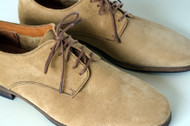Nubuck & Suede Leather Care
Posted by Daniel Sutton on Nov 2nd 2014
Unfinished leathers are one tough pickle. A single spill, one rough nick, a moment of careless tomfoolery – and everything goes down the drain. Merely mentioning suede or nubuck in the same sentence as leather care is enough to send a chill down the spine of even the most wrinkled leather scholars. Yet fear not, noble connoisseur of fine leather tastes! Today, we shall plunge head first into the very grain and fiber of your fuzzy-coated quandary!
For the uninitiated, unfinished leather is leather closer to its natural form. It possesses a flexible and supple texture, and is colored with dyes, which have penetrated deep into the leather to retain its hue. Finished leather, on the other hand, has a colder, less natural and more uniform appearance, but is more durable, having a protective coating that shields it from the elements. Finished leather is receptive to a wide variety of cleaners and conditioners, but you will have to take extra caution with unfinished leather, as its highly porous nature will mean that your leather care recipes will have a much more pronounced and lasting effect. You can read more about finished and unfinished leathers in our blog “Leather Care for Finished and Unfinished Leather Furniture.” Two of the most common unfinished leather types you are going to run into are nubuck and suede. We’ll give you the rundown.
Nubuck
Nubuck leather is what happens when top grain leather (read about leather grain types in our blog “Know Your Leather Grains”) gets buffed or sanded on the outside to create a napped, velvet-like surface. Naps being the short, fuzzy ends of your leather’s fibers that help give it that soft touch. Not the kind I’m contemplating after those fleeting four hours of sleep last night.
As I was saying, nubuck is buffed top grain with a velvet-like texture. It uses an aniline dye for color, but a light, transparent pigment can sometimes layer over the dye for moderate protection. If you don’t know very much about aniline dyes and pigments, you might find our blog “How to Identify Types of Leather” very helpful. This layer of protection, while useful, is not the pigment you would find on finished leathers. In fact, it's more likely you won't find these pigments at all. One of the nice advantages of nubuck is that it retains some of the natural markings present in full grain leather. For those desiring a more uniform, clean-looking surface, suede may be the better choice for you - but nubuck's natural coat and velvety luxury will be the apple of your eye if you've an eye for the rustic or the exotic.
Suede
Suede is a little different. Rather than using a layer closer to the animal's surface, suede uses leather closer to the fleshy interior. It's all sanded down and cleaned, mind. You'll end up with a material even softer than nubuck, with a flexible fold and consistent color to make it king of the indoor loafers. However, leather loses integrity the farther you cut down, and as suede is the delicate underbelly of our iron-scaled dragon, it's not going to be able to take as much heat as nubuck. In other words, don't expect to wear your suede slippers to a marathon.
To mitigate this shortfall, suede can come in its own protective coating. This is a great boon, as due to suede's very porous nature, it will absorb stains very quickly. However, more often than not, it is recommended that you apply a form of protectant to give it an extra edge. Speaking of which...
Care
Suede and nubuck leather care isn't all that different. Your main concern with nubuck is ensuring the velvet nap doesn't flatten when you care for it. Ditto on suede, although the nap is a bit more subtle. The naps tend to flow in directions, so if you can spot a direction the naps tend flow, move in that direction. This is most easily determine by brushing your leather's surface in various directions until you find the flow. If you're going on the wrong direction, the nap will feel rough, and in the right direction, smooth. Like stroking a cat, but less painful because leather usually no longer has claws. Win.
Generally speaking, nubuck and suede leather care won't require all that much work. These leathers can usually take care of themselves. They should be cleaned periodically, or whenever you spot dust building up. Use a soft, clean cloth and stroke gently to pick up any contaminants. In the event of a spill, I advise using a very lightly damp rag to pick it up if fresh. If a stain has set, you could try to sprinkle baking soda or corn starch over the stain and allow it to sit overnight. If the powder turns yellow in the morning, it's picked up some stuff. Lightly brush it off and continue this process until the stain disappears. If this does not work, seek out a leather cleaner designed particularly for suede or nubuck, or else visit a local leather professional to seek treatment.
Extra Layers
Because nubuck and suede have less protection on them than other types of leather, it is wise to use a leather protector. Like the aformentioned cleaner, use only recipes designed for nubuck or suede leather care specifically. The thick oils in conventional treatments - evenLeather Care Liniment- can build up inside suede's pores very easily and tarnish its softer texture. Light consistency protectors are the way to go, usually in spray form. Silicone sprays can be particularly effective for their waterproofing capacity, but it is always wise to test any leather treatment first in a discreet area to ensure best results. Silicone's unique abilities to waterproof leather will often negatively affect other kinds of leather that need to breathe to be maintained. If there are manufacturer instructions included with your suede or nubuck item, it is always best to follow these instructions for maximum return.
Other than that, keep with the standard rules for nubuck and suede leather care: avoid sunlight, keep in a cool, safe place where the leather won't get scratched up. Because of the looser integrity of suede and nubuck's fibers, dyes tend not to stick as well and will rub out more easily than other leathers. If this occurs, take the leather to a local leathercrafter to gain advice or apply leather dyes. Avoid spillage as much as possible, and when the inevitable accident does occur, treat quickly to prevent any lasting effects. It's best to keep your leather in a dust jacket or covered with a blanket when it's not being used, as leather, even suede and nubuck, can absorb elements from the air around it, even dust.
There's the Sum
That's the basics for nubuck and suede leather care. Because they do have a unique build, conventional leather care methods will not work for suede and nubuck leather. They will require separate care, although they are actually easier to maintain outside of scratches and spills. As nubuck and suede don't generally need to be conditioned, they will practically care for themselves, and take little effort to look absolutely fabulous. Like Barbie. No maintenance, instant style, and immortal appeal if you're the right audience. What? That's a no-go? Fine. Nubuck and suede are like [Insert Manliest Man Celebrity Here].

The “Insert” stands for Nathan Fillion.
Contributors
Daniel Sutton
Top Cleaning Secrets
Rave Fabric Care

